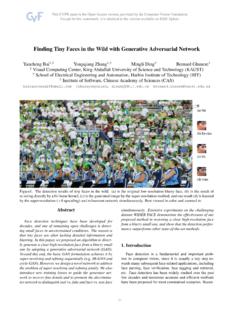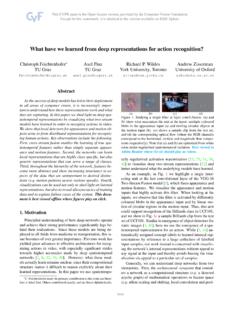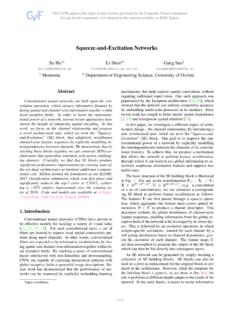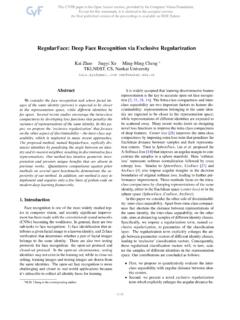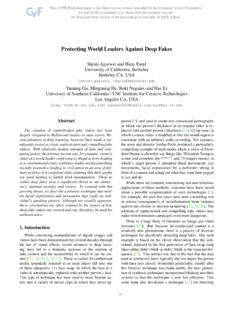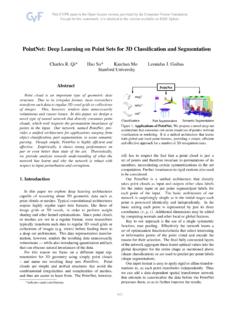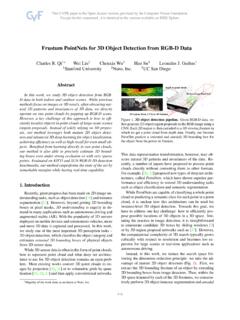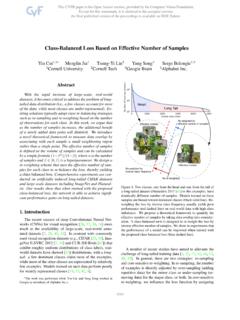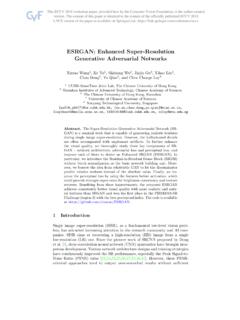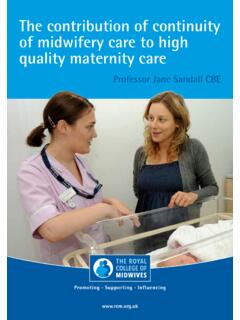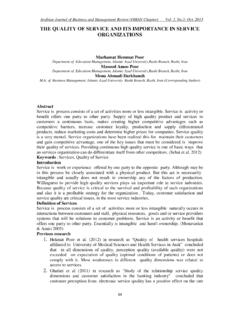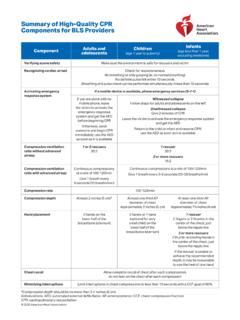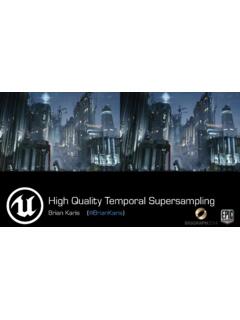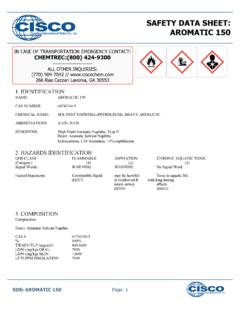Transcription of Cascade R-CNN: Delving Into High Quality Object Detection
1 Cascade R-CNN: Delving into high Quality Object DetectionZhaowei CaiUC San VasconcelosUC San Object Detection , an intersection over union (IoU)threshold is required to define positives and negatives. Anobject detector, trained with low IoU threshold, ,usually produces noisy detections. However, Detection per-formance tends to degrade with increasing the IoU thresh-olds. Two main factors are responsible for this: 1) overfit-ting during training, due to exponentially vanishing positivesamples, and 2) inference-time mismatch between the IoUsfor which the detector is optimal and those of the input hy-potheses. A multi-stage Object Detection architecture, theCascade R-CNN, is proposed to address these problems. Itconsists of a sequence of detectors trained with increasingIoU thresholds, to be sequentially more selective againstclose false positives. The detectors are trained stage bystage, leveraging the observation that the output of a detec-tor is a good distribution for training the next higher qual-ity detector.
2 The resampling of progressively improved hy-potheses guarantees that all detectors have a positive set ofexamples of equivalent size, reducing the overfitting prob-lem. The same Cascade procedure is applied at inference,enabling a closer match between the hypotheses and thedetector Quality of each stage. A simple implementation ofthe Cascade R-CNN is shown to surpass all single-modelobject detectors on the challenging COCO dataset. Experi-ments also show that the Cascade R-CNN is widely applica-ble across detector architectures, achieving consistent gainsindependently of the baseline detector strength. The code isavailable at IntroductionObject Detection is a complex problem, requiring the so-lution of two main tasks. First, the detector must solve therecognitionproblem, to distinguish foreground objects frombackground and assign them the proper Object class , the detector must solve thelocalizationproblem, toassign accurate bounding boxes to different objects.
3 Bothof these are particularly difficult because the detector facesmany close false positives, corresponding to close butperson: : : : : : : : : : : : : : : (a) Detection of = : : : : : : : : : (b) Detection of = IoULocalization Performancebaselineu= (c) Performanceu= (AP= )u= (AP= )u= (AP= )(d) DetectorFigure 1. The Detection outputs, localization and Detection perfor-mance of Object detectors of increasing IoU threshold .not correct bounding boxes. The detector must find thetrue positives while suppressing these close false of the recently proposed Object detectors are basedon the two-stage R-CNN framework [14,13,30,23], wheredetection is framed as a multi-task learning problem thatcombines classification and bounding box regression. Un-like Object recognition, an intersection over union (IoU)threshold is required to define positives/negatives. How-ever, the commonly used threshold values , typically = , establish quite a loose requirement for resulting detectors frequently produce noisy boundingboxes, as shown in Figure1(a).
4 Hypotheses that most hu-mans would consider close false positives frequently passthe While the examples assembled underthe = are rich and diversified, they makeit difficult to train detectors that can effectively reject closefalse this work, we define thequalityof an hypothesis as itsIoU with the ground truth, and thequality of the detectorasthe IoU threshold used to train it. The goal is to investi-gate the, so far, poorly researched problem of learning highquality Object detectors, whose outputs contain few close16154false positives, as shown in Figure1(b). The basic idea isthat a single detector can only be optimal for a single qual-ity level. This is known in the cost-sensitive learning liter-ature [7,26], where the optimization of different points ofthe receiver operating characteristic (ROC) requires differ-ent loss functions. The main difference is that we considerthe optimization for a given IoU threshold, rather than falsepositive idea is illustrated by Figure1(c) and (d), whichpresent the localization and Detection performance, respec-tively, of three detectors trained with IoU thresholds of = , , The localization performance is evalu-ated as a function of the IoU of the input proposals, andthe Detection performance as a function of IoU threshold,as in COCO [22].
5 Note that, in Figure1(c), each boundingbox regressor performs best for examples of IoU close tothe threshold that the detector was trained. This also holdsfor Detection performance, up to overfitting. Figure1(d)shows that, the detector of = the detec-tor of = low IoU examples, underperforming itat higher IoU levels. In general, a detector optimized at asingle IoU level is not necessarily optimal at other observations suggest that higher Quality Detection re-quires a closer qualitymatchbetween the detector and thehypotheses that it processes. In general, a detector can onlyhave high Quality if presented with high Quality , to produce a high Quality detector, it does notsuffice to simply increase during training. In fact, as seenfor the detector of = Figure1(d), this can degradedetection performance. The problem is that the distributionof hypotheses out of a proposal detector is usually heavilyimbalanced towards low Quality .
6 In general, forcing largerIoU thresholds leads to an exponentially smaller numbersof positive training samples. This is particularly problem-atic for neural networks, which are known to be very exam-ple intensive, and makes the high training strategy quiteprone to overfitting. Another difficulty is the mismatch be-tween the Quality of the detector and that of the testing hy-potheses at inference. As shown in Figure1, high qualitydetectors are only necessarily optimal for high Quality hy-potheses. The Detection could be suboptimal when they areasked to work on the hypotheses of other Quality this paper, we propose a new detector architecture, Cascade R-CNN, that addresses these problems. It is amulti-stage extension of the R-CNN, where detector stagesdeeper into the Cascade are sequentially more selectiveagainst close false positives. The Cascade of R-CNN stagesare trained sequentially, using the output of one stage totrain the next.
7 This is motivated by the observation that theoutput IoU of a regressor is almost invariably better thanthe input IoU, in Figure1(c), where nearly all plots areabove the gray line. It suggests that the output of a detectortrained with a certain IoU threshold is a good distribution totrain the detector of the next higher IoU threshold. This issimilar toboostrappingmethods commonly used to assem-ble datasets in Object Detection literature [34,9]. The maindifference is that the resampling procedure of the CascadeR-CNN does not aim to mine hard negatives. Instead, byadjusting bounding boxes, each stage aims to find a goodset of close false positives for training the next stage. Whenoperating in this manner, a sequence of detectors adapted toincreasingly higher IoUs can beat the overfitting problem,and thus be effectively trained. At inference, the same cas-cade procedure is applied. The progressively improved hy-potheses are better matched to the increasing detector qual-ity at each stage.
8 This enables higher Detection accuracies,as suggested by Figure1(c) and (d).The Cascade R-CNN is quite simple to implement andtrained end-to-end. Our results show that a vanilla imple-mentation, without any bells and whistles, surpasses all pre-vious state-of-the-artsingle-modeldetectors by a large mar-gin, on the challenging COCO Detection task [22], espe-cially under the higher Quality evaluation metrics. In addi-tion, the Cascade R-CNN can be built with any two-stageobject detector based on the R-CNN framework. We haveobserved consistent gains (of 2 4 points), at a marginalincrease in computation. This gain is independent of thestrength of the baseline Object detectors. We thus believethat this simple and effective Detection architecture can beof interest for many Object Detection research Related WorkDue to the success of the R-CNN [14] architecture, thetwo-stage Detection framework, by combining a proposaldetector and a region-wise classifier, has become predom-inant in the recent past.
9 To reduce redundant CNN com-putations in the R-CNN for speeds-up, the SPP-Net [17]and Fast R-CNN [13] introduced the idea of region-wisefeature extraction. Later, the Faster R-CNN [30] achievedfurther speeds-up by introducing a Region Proposal Net-work (RPN). Some more recent works have extended it toaddress various problems of detail. For example, the R-FCN [4] proposed efficient region-wise fully convolutionswithout accuracy loss, to avoid the heavy region-wise CNNcomputations of the Faster R-CNN; while the MS-CNN [1]and FPN [23] detect high -recall proposals at multiple out-put layers, so as to alleviate the scale mismatch between theRPN receptive fields and actual Object , one-stage Object Detection architectureshave also become popular, mostly due to their computa-tional efficiency. YOLO [29] outputs very sparse detectionresults and enables real time Object Detection , by forward-ing the input image once through an efficient backbone net-work.
10 SSD [25] detects objects in a way similar to the RPN[30], but uses multiple feature maps at different resolutionsto cover objects at various scales. Their main limitation is6155that their accuracies are typically below that of two-stagedetectors. Recently, RetinaNet [24] was proposed to ad-dress the extreme foreground-background class imbalancein dense Object Detection , achieving better results than state-of-the-art two-stage Object explorations in multi-stage Object Detection havealso been proposed. The multi-region detector [10]intro-ducediterative bounding box regression, where a R-CNNis applied several times, to produce better bounding boxes.[36,12,11] used a multi-stage procedure to generate accu-rate proposals, and forwarded them to an accurate model( Fast R-CNN). [37,27] also attempted to localize ob-jects sequentially. However, these methods usually used thesameregressor iteratively for accurate localization. [21,28]embedded the classic Cascade architecture of [34] in objectdetection networks.
